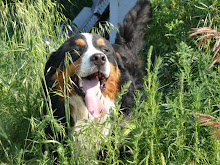
Yes, these really are cattle not sheep, free range cattle, enjoying the sunshine after the Colorado blizzard of Spring 2007
Cattle raised for beef may be born in one state, fattened in another, and slaughtered in yet another. They are fed an unnatural diet of high-bulk grains and other “fillers,” which can include expired dog and cat food, poultry feces, and leftover restaurant food. They are castrated, their horns are ripped out, and they have third-degree burns inflicted on them (branding)—all without any painkillers. During transportation, cattle are crowded into metal trucks, where they suffer from trampling, temperature extremes, and lack of food, water, and veterinary care.
What a load of red herrings!! The truth is you really couldn't find anythi9ng bad to say about raising beef cattle so you had to throw in a load of totally irrelevant information.
Most beef calves are raised by their mothers on pasture until they are six months old. Depending on the climate the mothers may be kept on pasture year round or moved to corrals for the winter and calving seasons.
Weaned calves may continue to be fed on pasture or may be moved to a feedlot.
There are huge differences among feedlots, in the weight of the cattle and the types of feeds fed. Feedlots tend to have very specialised management practices depending on the type of beef produced. Their market may be other beef producers who will finish the cattle, or it may be directly to processors or consumers. The size of a feedlot may range from a few animals to operations of 40,000 head. What is important is not the size of the operation but the dedication and skill of the stockman.
Wherever the cattle live, whether in a feedlot where they are fed automatically from a truck, or out on the range where they munch on grass and drink from a creek, they are checked every day by a competent and experienced stockman who checks them for signs of injury or illness, (and treats them accordingly) makes sure they all have access to feed and water and checks the fences to make sure they cannot stray onto nearby roads or farmers crops.
Most cattle are now tagged for identification purposes instead of branded. They are indeed castrated and dehorned without the use of painkillers. However, castration only takes a few seconds and quickly heals. A little pain can go a long way to promote healing as it encourages the calf to protect his rear end and not go fighting or rough and tumbling too much with his mates. It is also important to not here that only male calves have to be castrated.
Horns are not "ripped out" they are either cut or burned off when the animal is young and the horns are still small. It should be noted that not all cattle have to be dehorned. The ranges aren't dominated by Texas Longhorns any more, most breeds are naturally polled, which means they never grow any horns in the first place.
Lack of food water and veterinary care during transportation is irrelevant as most journeys are short. Trucks are well ventilated and their is adequate movement of air over the animals while the truck is in motion (imagine yourself sitting next to an open window on a car journey.
Calves raised for veal are the male offspring of dairy cows. They’re taken from their mothers within a few days of birth, and they are chained in stalls that have slatted floors and are only 2 feet wide and 6 feet long. Since their mothers’ milk is used for human consumption, the calves are fed a milk substitute that is designed to help them gain at least 2 pounds a day. The diet is purposely low in iron so that the calves become anemic and their flesh stays pale and tender.
I don't like the idea of raising veal calves any either, but lets face it, until such time as dairy farmers can get their cows to produce only heifer (female) calves, they will continue to produce at least 50% bull calves and something has to be done with them. Dairymen could kill bull calves at birth, and in fact some do, but if such practice were to become widespread it would attract equal criticism from peta as raising them for veal does.
So the dairymen make the best they can of a bad situation and raise bull calves for veal.
Some veal calves are now raised in group pens with an automatic feeding system. However, this is a trade off as the pens tend to be dirtier and wetter. This allows for the spread of disease-causing organisms and it is more difficult to identify and treat a sick animal.
The meat remains light due to the milk diet not because the calves are anemic.
Just as a point of interest it should be noted that in England where veal production is almost non-existent. Consumption of veal has continued to increase (imported from France)
Quote of the day
"We have no ethical obligation to preserve the different breeds of
livestock produced through selective breeding. ...One generation and out.
We have no problem with the extinction of domestic animals. They are
creations of human selective breeding."
Wayne Pacelle
President of HSUS
Animal People May 1993

1 comment:
this peda quier is rediculous
Post a Comment